Topic: Optimization
Optimization
The Marcellus Shale
The Marcellus shale is a black shale formation that was formed during the Middle Devonian Period. The shale extends from New York State as far south as Alabama. The Marcellus shale is exposed at the surface in the northern Finger Lakes region, and is buried 2.1 kilometers below the surface along the New York-Pennsylvania border.
Geologists estimate that the Marcellus shale contains hundreds of trillions of cubic feet of natural gas. Most of the Marcellus shale does not allow fluids (gases and liquids) to flow through the rock. In order to obtain the natural gas trapped in the rock, the shale is fractured. This hydraulic fracturing consists of drilling a well, then pumping in large amounts of water containing chemicals and sand under high pressure to create cracks in the gas-bearing rock. Although this process can allow the trapped gas to be removed from the shale, opponents of hydraulic fracturing argue that the chemicals used in the process may lead to groundwater contamination.
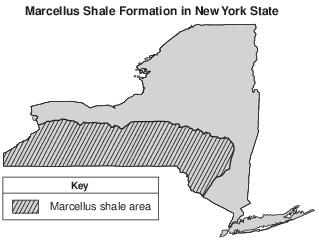
Why might people living near Elmira, New York, be opposed to energy companies using the hydraulic fracturing process?
(1) It could lower their energy costs.
(2) The injected water could cause flooding in the area.
(3) There is the potential for the pollution of groundwater.
(4) There is an increased risk of volcanic activity.
Which event is inferred by most scientists to be responsible for a climate change that has recently led to a decrease in the size of most glaciers?
(1) a decrease in the rate of divergence of lithospheric plates along a mid-ocean ridge
(2) a decrease in the amount of insolation reaching Earth’s surface
(3) an increase in the amount of greenhouse gases in Earth’s atmosphere
(4) an increase in the amount of vegetative cover in the tropics
Which gas is a greenhouse gas that has increased in Earth’s atmosphere partly as a result of deforestation over the last 100 years?
(1) ozone
(2) oxygen
(3) nitrogen
(4) carbon dioxide
The north polar view maps below show the average area covered by Arctic Sea ice in September of 1980, 2000, and 2011.
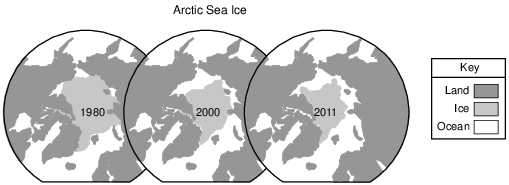
The maps best support the inference that Earth’s climate is
(1) cooling, because the average area covered by Arctic Sea ice is decreasing
(2) cooling, because the average area covered by Arctic Sea ice is increasing
(3) warming, because the average area covered by Arctic Sea ice is decreasing
(4) warming, because the average area covered by Arctic Sea ice is increasing
Which list contains three major greenhouse gases found in Earth’s atmosphere?
(1) carbon dioxide, methane, and water vapor
(2) carbon dioxide, oxygen, and nitrogen
(3) hydrogen, oxygen, and methane
(4) hydrogen, water vapor, and nitrogen
On the grid in the image provided, construct a topographic profile along line CD by plotting the elevation of each contour line that crosses line CD. Connect all the plots with a line to complete the profile. [1]
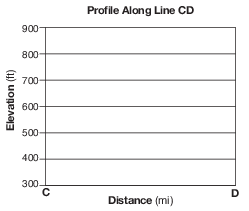
Allow 1 credit if all five plots are within the circles shown below and are correctly connected with a line that passes within each circle. The line should extend below 500 ft but above 400 ft in the creek valley.
• Note: It is recommended that an overlay of the same scale as the student answer booklet be used
• to ensure reliability in rating.
• 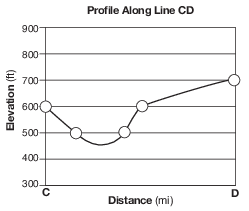
Solar Heating
Solar collectors in solar heating systems harness the power of the Sun to provide thermal energy for heating hot water and house interiors. There are several types of solar heating systems. The best system will depend on the geographic location and the intensity of the Sun. A solar heating system saves energy, reduces utility costs, and produces clean energy. The efficiency and reliability of solar heating systems have increased dramatically in recent years.
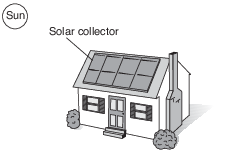
State one advantage of using solar energy instead of burning fossil fuels to produce thermal energy for your home. [1]
Allow 1 credit. Acceptable responses include, but are not limited to:
• — saves energy
• — reduce utility costs
• — produces clean energy
• — A renewable source of energy has less effect on the environment.
• — less pollution/CO2 emissions/reduced carbon footprint/less global warming
• — conservation of fossil fuels
• — Solar energy is renewable.
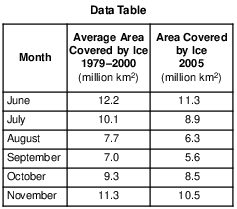
Identify one greenhouse gas that is believed to cause global warming. [1]
Allow 1 credit. Acceptable responses include, but are not limited to:
• — carbon dioxide or CO2
• — methane or CH4
• — water vapor or H2O gas
• — nitrous oxide or N2O
• — ozone or O3
• — chlorofluorocarbons or CFCs
